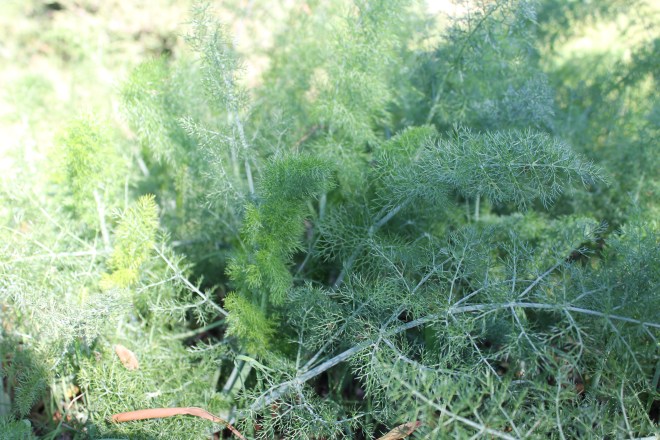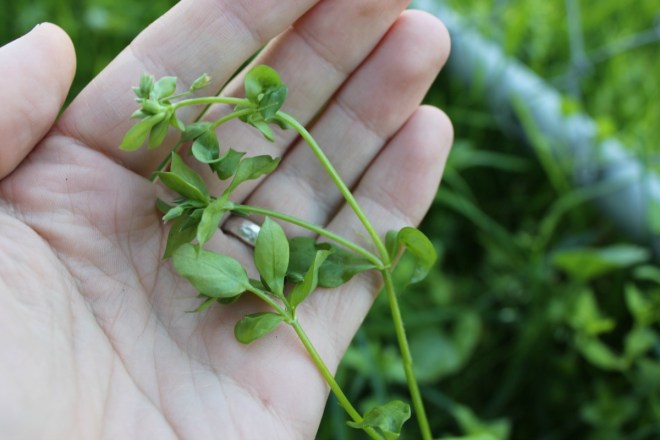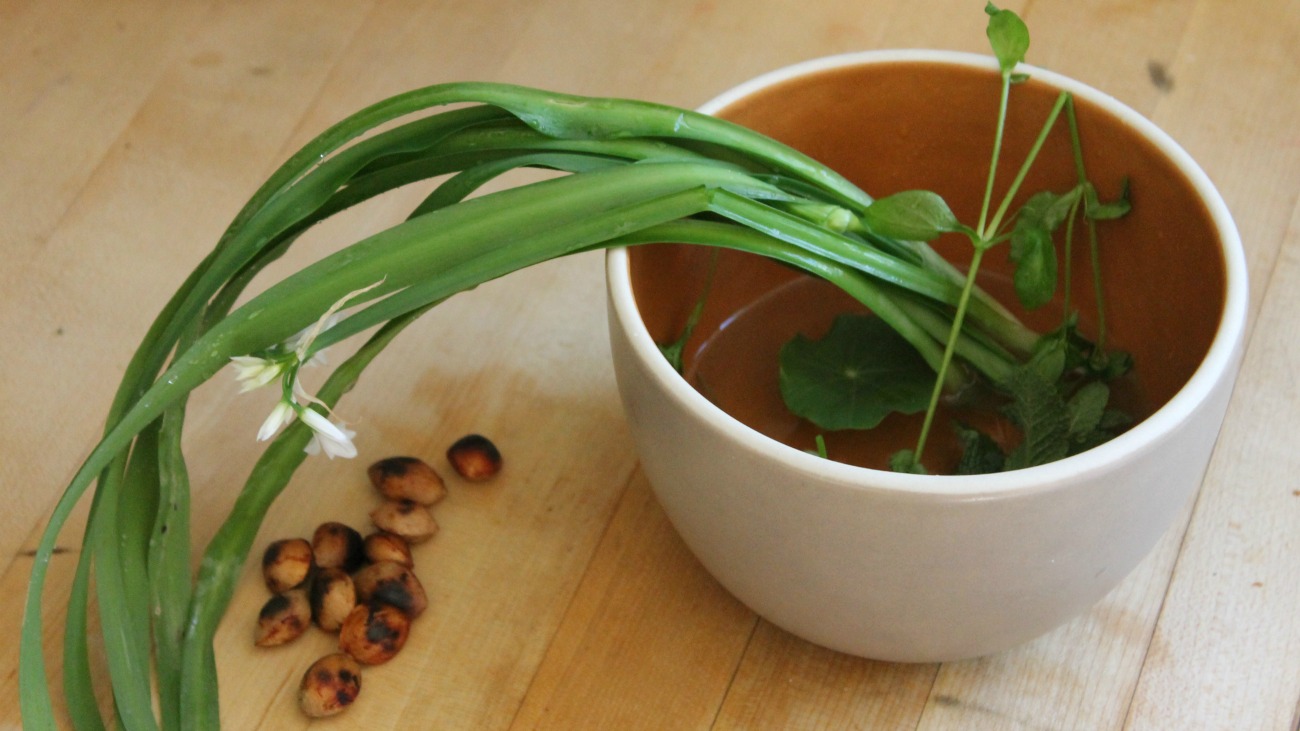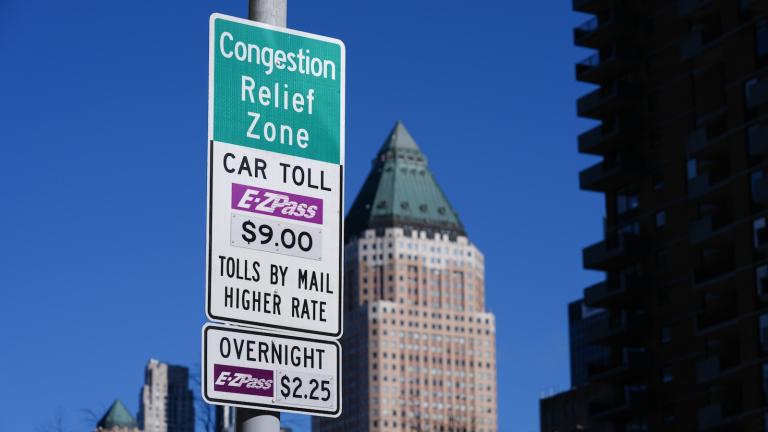What if we connected the people most in need of healthy food with the expensive, nutrient-dense greens that just happen to be growing between the cracks in their driveways? A project at UC Berkeley is testing out this idea. Philip Stark, chair of the Berkeley statistics department, has organized a team of researchers to map edible plants in low-income neighborhoods, with the goal of creating a website that will show residents how to find food close to their homes.
In the U.S., poverty is highly correlated with obesity and diet-related disease. If poor people actually found it feasible to eat foraged greens, the public health benefit could be immense. And incidentally, the places labeled as food deserts — the low-income neighborhoods without markets, but plenty of overgrown yards — are also the places where Stark is finding the most edible weeds. “The hypothesis is that the food is already there,” he said. “It’s just not recognized as food.”
I asked Stark if I could tag along with him some time when he went out looking at plants, which he said he does nearly every day. We met at his home in the Berkeley hills and strolled the winding roads.
A walk with a forager is not a leisurely expedition. Stark did not gaze out at the vistas, nor remark on the architectural details of the houses we passed. Instead, he stared intently at the margins of the road, and regularly broke off mid-sentence to dash to one side or the other and inspect something green and nondescript. He is tall, lean, and balding, with close shorn hair and a week’s worth of bristles on his face. He wore sandals (a simple sole attached to his foot with leather laces), loose gray pants, and an unblemished rust-orange Arc-Teryx windbreaker. He rattled off Latin and common names faster than I could write them down. “Lactuca virosa,” he said, squatting and plucking a hairy leaf. “Opium lettuce, or bitter lettuce.” He put it into his mouth and chewed. I did the same. It was bitter, not overwhelmingly so, but also not something I’d want to eat in bulk. “I actually quite like things with stronger flavors,” Stark said. He’ll use a bitter leaf or two like a spice, to punctuate an otherwise conventional omelette or piece of meat.

Wild onion.
A little farther on we came to a little sloping triangle of dirt between a driveway and the road. Stark began listing the edible species there. “Bristly ox tongue, curly dock, miner’s lettuce, mallow, fennel, chickweed, sow thistle, cow parsnip, wood sorrel, nasturtium … Here’s a 10-ingredient salad, more than you could get in a mixed mesclun bag at the farmers market. And it’s free.”
On the second day of official fieldwork for the project, Stark told me, he and his compatriots bumped into another team looking for precisely the same plants. It was a team of city workers in hazardous-materials suits, spraying herbicide to kill the greens. They were in West Oakland, where lived people whose diets would surely be improved by eating those weeds. Here were two problems — people in need of free health food, and weeds in need of removal — that might be combined to form a single solution.
Let’s call it a potential solution for now. There are still issues to sort out. First, is it safe to eat greens growing amid herbicide, auto exhaust, dog poop, and the mystery fallout of urban grime? Second, will the people who most need more greens in their diet have the time to forage, and wash, and cook them?
Stark is running a battery of tests to answer the first question. Plants do absorb pollution, but it’s unclear if they take in enough to cause a concern.
The second question is tougher. Foraging makes perfect sense if you are cash poor and time rich. But it makes no sense when you’re working three jobs and still broke. Several attempts to fix food deserts have failed because the problem isn’t simply that people lack access to vegetables — they also may not have the skills to make them delicious, or the time to prepare them.
Let me admit here to some skepticism about urban foraging. It’s a skepticism that comes from listening to the edible-plants people, who share valuable knowledge but always seem to insist on mixing in a liberal helping of dubious claims. The foragers who are particularly prone to making assertions that are fantastic (if you want to be polite) or obviously false (if you don’t) can be divided into three categories: the survivalists, the herbalists, and the tastebud-less.
The survivalists were the ones with the conviction that they could someday subsist on plantain heads and dock leaves. Rebecca Lerner carried out that experiment, and described it in her book, The Dandelion Hunter. After a week of living off the land in Portland, eating salads and weak, vegetative teas, she wrote:
My body was achy and limp. My legs were so weak that I had to brace myself against the wall like an old lady who lost her walker.
She wisely gave in, and cut off her experiment to gorge on Thai food, noting, “There’s a thin line between badass and dumbass.”
The herbalists are the ones who insist on telling me that such and such is good for the liver or will flush out my toxins. I’m a fan of alternative medicine, but when I’m trying to learn something I like my information to be evidence-based. When someone tells me earnestly that Echinacea cures colds (even though I know it’s been studied to death and ultimately looks like a good placebo) it makes me doubt everything else I’m learning from them.
Then there’s the tastebud-less: The folks that munch on tough old dandelions and proclaim them delicious. As Tama Matsouka Wong writes in her book Foraged Flavor, it’s easy to find books to tell you what is edible, but the “existing books offered recipes with instructions such ‘parboil in water three times to remove bitterness’ or ‘braise the milkweed shoots for two hours.’ It sounded too much like space shuttle or survival food — the kind of thing you would only eat if you were starving in the wilderness!” The highest praise in many guides is “mildness” — the ability of a plant to pass through your mouth undetected. One of the books in that vein is Edible Wild Plants of Eastern North America, by Alfred C. Kinsey; it contains a comprehensive listing of species, but doesn’t tell you what to do with them. (The same might be said, incidentally, of Kinsey’s more famous reports on human sexuality — plenty of facts, but no advice for the lay reader on putting them into practice.)
The foraging literature frequently ignores flavor — there’s a touch of the apocalyptic asceticism in many of the guidebooks. They carry the implication that, come the cataclysm, there will be no place for those who hesitate to scarf down hairy bittercress.
These three breeds of forager specialize in promising far more than is reasonably possible. So if you’re skeptical about the possibility of low-income Americans foraging in cities for bitter greens, I get it.
But we shouldn’t let the hyperbolic foragers out there spoil what, done right, can be a truly good thing. The people who stick with it eventually figure out that dandelion greens won’t feed the starving, and that edible does not equal delicious. (Sadly, though, it seems harder to shake the habit of pronouncing herbs cure-alls.) Experienced foragers understand that you can’t actually survive on wild salads alone: It’s fruits, nuts, seeds, roots, and meat that provide the calories. In her book, Lerner eventually finds her foraging groove; with the help of a small village of friends, she assembles a Thanksgiving dinner which she calls “an impressive display: rose hips sauce, roasted cattail, nettle, mushrooms, wapato, venison, scones, and even wild beer.”
I’d be pleased to get that at a fancy San Francisco restaurant.

Fennel.
And of course, the finest restaurants are serving foraged weeds already. Daniel, the New York eatery with two Michelin stars, and Copenhagen’s Noma, often called the best restaurant in the world, both rely on foraged foods — tapping the flavors and textures of things people normally don’t think of as food.
The success of those restaurants renewed my interest in foraging. I have no desire to be the sort of guy who tries to serve his family survivalist salads of the “actually, starvation is sounding pretty good right now” school. But Wong, who forages for Daniel, has published a book full of recipes and advice for turning weeds into high cuisine.
We’ve reached a strange moment when foraging is firmly associated with upper class food — so much so that it’s impossible to say you are serving, for example, foraged sheep sorrel or wild fennel sprigs without it sounding a bit pretentious. This is strange, because foraging was once a refuge for the desperately poor, and still is in many places.
In 1922, Euell Theophilus Gibbons was 11 years old, and his family was starving. His father had left their homestead in rural New Mexico to look for work, and his mother was sick — she was giving the food she had to her four children, rather than eating herself. They ate their animals, one by one. The horse died, and the family dog ate her. The 11-year-old Gibbons went out looking for food — and he found it. He found rabbits and prickly pears, mushrooms and berries. He fed his family every day for a month until his father returned. And he never stopped foraging.
Forty years later — 40 years spend hoboing, and cotton picking, and bronco busting, and working as a communist agitator — Gibbons wrote a book about foraging titled Stalking the Wild Asparagus. It was a bestseller. It’s this book that seeded the idea of foraging into the nascent environmental movement, setting the taproot for the later success of restaurants like Daniel. The root of our current fussy fascination with foraging was a hungry kid in New Mexico, searching the desert for something he could give his mother.
Gibbons counsels that deep wilderness is a poor place to go looking for food. The best spots, he writes, are “old fields, fence rows, burned off areas, roadsides, along streams, woodlots, around farm ponds, swampy areas and even vacant lots.” The plants that are good for people to eat travel and live with us. Dandelions came to the New World on the Mayflower, though historians don’t know if they were meant to be a medicine or food. (Dandelions can provide real sustenance if you dig up their starchy roots, rather than trying to eat their leaves.)

Sourgrass or wood sorrel.
I’ve been researching the plants and animals that thrive alongside humans, and that’s what got me interested in foraging. My research is for a book I’m writing — a sort of urban field guide to the species that are so common they’ve become invisible. I tend to dislike invasive plants, because they take over and crowd out diversity. But when I began to look closely at these weeds I saw a lot to admire. They grow in incredibly hostile environments, without water, fertilizer, or even soil. They grow despite the fact that people frequently pull them up and poison them. They are tough, versatile, and resilient. And, as Wong points out, the chemicals that make these weeds so strong also give them the powerful flavors prized by chefs. There’s something about these flavorful plants that seems to endow the people who eat them with health — these phytochemicals are mysterious because they are frequently poisons, produced by plants to keep themselves from being eaten. But the theory is that, because we evolved eating low doses of these toxins, we need them: They create a stress response, much like exercise does, and give your system a work out.
Eating weeds has allowed me to engage with the natural world in a new way. I chew on peppery nasturtium leaves on my way to work. When I’m making a sandwich and realize we’re out of greens, I just go outside and grab some. I pluck unfamiliar plants and take them home for identification.
“Once your brain registers that there’s food out there, your brain starts interacting with the environment in a different way,” Stark told me. I believe it. What was once just a green jumble in every unmown verge has began to gain focus for me.
My 3-year old, who never learned not to see these plants, can identify almost as many species as I can. As a game, I’ll sit on our stoop and send her off to search for oxalis or dock, and a few minutes later she’ll come running back with the correct leaf. She normally hates to eat anything green, but she’ll happily sample what she gathers. It still seems miraculous to me that toddlers — and all of us actually — can pick one nondescript plant out of many. When you learn an edible plant, there’s something that clicks into place. Here’s how Gibbons described it to the writer John McPhee:
It’s exactly like recognizing someone’s face; once you know a person, you know that person from all other people. If you came home at night and a woman you had never seen was standing in your house, you wouldn’t think it was your wife. God help you anyway if you would.
The contemplative pleasure of getting to know my natural neighbors is a middle-class luxury. I don’t think I’d be taking the time to learn and taste my weeds if I was a single parent, hustling to get my kids fed and into bed. I might, however, have the time if I were a child of that single parent — like Gibbons. There’s often at least one person in a household who could make time to forage if they knew how, or had a good mentor.
There’s a sense of rootedness that comes with knowing the wild things in a place, and a satisfaction that comes with finding food to help support your family. I’m not talking like a survivalist here — there’s no way people in West Oakland are going to get the bulk of their calories from weeds any time soon. I’m just pointing out that a small helping of foraged greens each day could make people healthier, even if it’s layered in a fast-food hamburger to provide some crunch.

Chickweed.
There’s no need to make airy claims about the detox powers of wild plants, when we can instead point to the clear, well-established, and powerful benefits of eating leafy green vegetables. Perhaps we’d all be better off, poor and middle class alike, if we could open our eyes to the natural world around us and see the richness there that we usually miss.
I’d say that urban foraging is a long shot, in terms of its chances to be an effective intervention against obesity. But is foraging any more of a long shot than urban gardens? When the Obamas planted a garden on the White House lawn it became a symbol of the struggle to get fresh healthy food into the hands of ordinary Americans. I’m a supporter of gardens in general, and that garden specifically. But I’d like to point out that it was preceded by other symbols on the White House lawn. Once, many years before anyone knew the name Obama, Euell Gibbons put his arm through the fence surrounding the White House to pick four different edible plants. The food is there, if we have eyes to see it.




